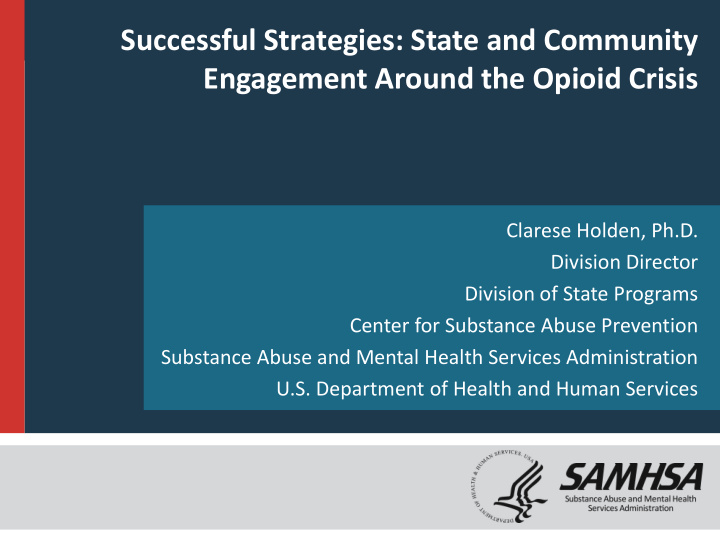



Successful Strategies: State and Community Engagement Around the Opioid Crisis Clarese Holden, Ph.D. Division Director Division of State Programs Center for Substance Abuse Prevention Substance Abuse and Mental Health Services Administration U.S. Department of Health and Human Services
HHS Opioid Initiative 2016 21st Century Cures Act (Public Law 114-255) • Department of Health and Human Services’ (HHS) strategic effort to address the non-medical use of prescription drugs and opioid overdoses • $500 Million for FY 2017 and $500 Million for FY 2018 • Subject to the appropriations process for each fiscal year 4
Allowable Activities • Train healthcare practitioners on topics such as best practices for prescribing opioids, pain management, and referral of patients to programs • Address barriers to receiving treatment; developing systems of care to expand access; engaging and retaining patients in treatment • Train physicians, nurses, NPs, PAs, counselors, social workers, care coordinators, and case managers in addressing OUD • Support innovative tele-health and social media programs to reach rural and underserved areas • Purchase and distribute Naloxone and train multiple audiences to administer • Enhance the PDMP to increase sharing and use of data • Establish statewide community-based recovery support systems and networks 5
Strategies Disposal Monitoring Education Enforcement 4
Strategic Prevention Framework (SPF) 5
Prevention Discretionary Grant Programs • Strategic Prevention Framework – Partnerships for Success (SPF-PFS) • Strategic Prevention Framework – Prescription Drugs (SPF- Rx) • Grants to Prevent Prescription Drug/Opioid Overdose Related Deaths (PDO) • First Responders – Comprehensive Addiction and Recovery Act (FR-CARA) • Improving Access to Overdose Treatment (IAOT) • State Targeted Response to the Opioid Crisis Grants (STR - Opioid) 8
Prevention Opioid Activities • Drug Disposal - This initiative encourage the proper disposal of medicines and help reduce harm from accidental exposure or intentional misuse after they are no longer needed by allowing the public to take unused drugs to a central location for proper disposal. • Overdose Education and Naloxone Distribution (OEND) - Providing opioid overdose education and naloxone to persons who use drugs, and training persons who might be present at an opioid overdose to help reduce opioid overdose mortality. • Design, implement, enhance and evaluate primary and secondary prevention using EBPs to reduce the number of persons with OUD and OUD associated deaths 8
Treatment Prevention Activities • Implement or expand access to clinically appropriate evidence-based practices for OUD treatment, particularly the use of medication-assisted treatment, i.e. the use of FDA-approved medications. • Provide treatment transition and coverage to patients re- entering communities from criminal justice settings • Enhance and support the provision of peer and recovery support services designed to improve treatment access and retention and support long-term recovery 8
What the States and Territories are Doing • Developing Hub & Spoke systems – based upon Project ECHO developed by the University of New Mexico • Linking non-fatal overdose patients to community services • Mobile outreach • Increase access to naloxone for law enforcement and other first responders • Infrastructure expansion and surveillance – expanding the use of their PDMP • State policy/protocol development – forming State Opioid Taskforces • Establishing pre-release programs for incarcerated individuals • Development of Practice Guidelines related to Strength-Based Assessment and, for individuals presenting in active substance withdrawal 8
What the States and Territories are Doing (continued) • Implementing core competencies related to prevention and management of prescription drug misuse for medical professionals • Setting prescription limits for the dispensing of opioid prescriptions to limit first time exposure to opioids • Training prescribing personnel and other healthcare providers on the CDC prescribing guidelines • Initiating and expanding school and community-based prevention efforts to include students, families, and communities through drug awareness and education • Expanding the number of Data 2000 waivered physicians and OTPs • Telephonic and social media based recovery check-ups and support 8
Resources SAMHSA Opioid Prevention Toolkit 11
Recommend
More recommend